|
| The History Center on Main Street, 83 N. Main Street, Mansfield PA 16933 histcent83@gmail.com |
|
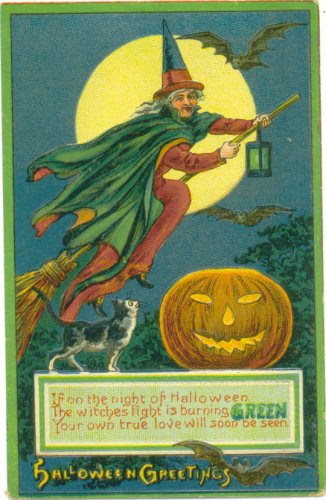 |
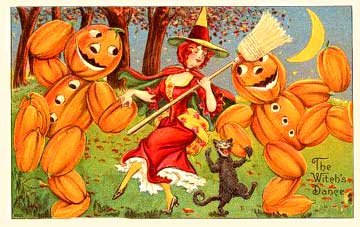 |
|
Painting store windows in Mansfield – Mansfield PA in the 1950s always put on a "Big Do" for Halloween as did many small towns at the time. Some still do, and Halloween, to this day, is economically second only to Christmas in the amount of money spent on it. The 1950s era event included a big parade of costumed participants with cash prizes for categories which included, elementary to sixth grade, junior high, senior high, and adult. Additionally, a free movie at the Twain theater was part of the celebration following the parade. In 1951, according to the Mansfield Advertiser, the first show was open to all costumed children. The second show was "free to any who can fit into the theater."
The event was sponsored, and had been for the "past four or five years," through the cooperation of several Mansfield organizations, including the VFW, Mansfield Lions, Mansfield Hose Company, Mansfield Boro Council, Smythe Park Association, and the Mansfield Business Mens’ Association. [Yes, this did mean MEN. Sadie Finesilver, Mabel Wright, Genevieve Shaw and other women business owners in Mansfield were not welcome, thank you very much.] Band music and floats were also included in the parade. Throughout the decade every first of November Mansfield Advertiser announced that" this year's parade was the biggest ever held here." The 1952 parade included four bands.
In 1954, for the first time, the Mansfield practice of painting the store front windows in the business district was introduced. This was under the direction of Dr. Stephen Bencetic, art professor at the college and the junior high school. In announcing this first time event, the Mansfield Advertiser says that it was done by Dr. Stephen Bencetic and the College Art Department. It is not clear about whether the college students did the painting or supervised. In later years the painting was done by junior high art students supervised by college students, but in the first year’s article, junior high students are not mentioned.
In 1955, 190 Art Studies students under the direction of Dr. Stephen
Bencetic and 54 college sophomores painted some 40 store windows. (Numbers
are inconsistent in the late October issue announcing plans, and the early
November issue reporting what happened) They did it on two afternoons,
and they were judged on originality, simplicity, and appropriateness. First
Prize went to "Old Church Yard" on one of the T. W. Judge Store windows
on South Main Street. The winning team from homeroom 8C included Gwen Clark,
Sandra Crippen, Linda Rarick, Ann Wilson, and Darel Cummings. In the same
year Joann Ennis won first prize for costumes in the elementary division
and the Boy Scouts won first prize for the Floats.
| 1955 | |||
| Windows 1st prize | "Old Church Yard" | T. W. Judge | 8c Gwen Clark, Sandra Crippen, Linda Rarick, Ann Wilson, Darel Cummings |
| 2nd prize | "The Witch" | Estep’s Jewelry | 7a John Estep, Shirley Rose, Tim Sumner, Mary Jane Hill, Joyce Carnwright |
| 3rd prize | "The Pumpkin Ghost" | Main Appliances | 9a Mary Jane Colegrove, Patty Keiss, Barbara Jenkins, Dickie Roupp |
| 4th prize | "The Skeleton" | Strait’s Hardware | Barbara Page, Mary Ann Goodall, Mary Jo Smith, Marlene Mitchell |
The windows were painted with bright tempura paints that washed off easily after the event. I don’t recall offhand what happened if it rained or who cleaned them off after the event. I think the storeowners did it themselves
Poring blissfully through my fifty year stash of old Mansfield Advertisers,
I am able to find the following articles. [Thanks to the late Myrtle McKAY
Strange for saving the papers and to her son-in-law John Barr for turning
them over to my museum/library. Some issues are missing and some are damaged,
so information in not complete.] Prize winners in subsequent years follow:
| 1956 | |||
| Costumes | Jr. High Division 1st prize | Billy Gee, Tommy Husted | |
| Windows 1st prize | "Heartbreak Hotel" | Power Company | Darwina Neal, Kathy Francis, Rosamand Cleveland, Judy Whittaker |
| 2nd prize | "Witch & Cracked Pumpkin" | Preston’s | Judy Besanceny, Karen Vosburg, Barbara Wallenberg, Jerry Smith, Peggy Kiess |
| 3rd prize | "Don’t Step on my Blue Suede Shoes" | Finesilver’s | Linda Crittenden, Diane Gillespie, Pat Jones, Carolyn Bovier, Elaine Bryant, Dick Thatcher |
| 4th prize | "RedRiding Hood & Ghost" | Garsides | Shirley Rose,Sylvia Longwell, LorettaBartlett, Larry Wright, Gary VanNocken |
| 1957 | |||
| Windows 1st prize | "Rock Pretty Baby" | Wright Shop | Barbara Mortimer, Ronnie Somogy, Fred Sparling, Candy Skoreski, Paul Bailey |
| 2nd prize | "The Genie" | Strait’s Hardware | Monema Clark, Jeanne Morgan, Carol Comfort, Renah Merrick |
| 3rd prize | "The Flight" | Ralph’s Ford | Judy Besanceny, Mike Cunningham, Susan Rush, Karen Vosburg, Kate Baum, |
| 4th prize | "Calypso Ghost" | Ellamae’s Beauty Shop | Tim Sumner, Ann Chamberlain, Tressa Brace, Donna Hulslander, Marion Martin |
In 1958, the 18 year old event had to be removed to the college gym because of rain. Only the two bands had to be cancelled. The October 15 and October 29 issues of the Mansfield Advertiser say that Prof. Bencetic will be in charge of the window painting project. The November 4 issue lists all costume and float prizes, but does not mention the windows. Perhaps they, too, were rained out ?? Prof. Bencetic had selected some "famous persons" to be judges, but the date was set as weather dependent.
In 1959, the paper indicated that both junior and senior High school
students participated in the window painting. Judging occurred before the
other Halloween events. Paintings were not names as in earlier years.
| 1959 | ||
| 1st prize | Main Appliances | 7 Jim Spalding, Thomas Brace, Don Callihan, Cheryl Trowbridge, Lucian Mitcheltree, Carl Matteson |
| 2nd prize | Finesilvers | 8 Pat Baker, Susan Creeley, Elsie Tice, Joan Kshir, Dick Broadfield, Richard Giles |
| 3rd prize | Ford | 7 Toni Jessup, Cheryl Moore, Lorraine Hall, Sylvia Inscho, Ellen Stickler, Margaret Robbins |
| 4th prize | Preston’s | 7 Sabra Bradley, Marshall McClure, Joseph Chapel, William Clark, Kathryn Frost, Edith Marple |
| 1960 | Eugene Seeley, Wellsboro Art Teacher, one of the judges | |
| 1st prize | Stores not mentioned | Carolyn Rieppel, Helen Gillespie, Lonnie Smith, Arlene Hagar, Eric Husted |
| 2nd prize | Ed Farrer, Tom Brace, Barton Dandois, Sonya Rice, Bonnie Baynes | |
| 3rd prize | Marie Cunningham, Joan Allen, Ruth Rodgers, Linda Moore | |
| 4th prize | Jerry Comfort, David Barden, Byron Van Noy, Sylvia Inscho, Sandy Whittaker, Ann Lee Kuhl | |
| Honorable Mention | Toni Jessup, Gary Shaw, Linda Rasmussen, Steve Sanders, Betsey Brace, Flinn Boyden |
Quite a few issues are missing from my 1961 collection of Mansfield Advertisers, so I don’t know what happened in the window painting arena. In1962, window painting is not mentioned in the newspapers. Face Painting was well received the previous year and will be repeated and judged in the 1962 celebration.
Apparently 1960 was the end of the era. This coincided with the opening of the new school that combined the Junior and Senior High Schools in one building, on the location that had been just the Senior High School. Prior to this the Junior High had been part of the college campus and was closely associated as a training environment for student teachers. Since the program was managed by Professor Bencetic, that may be the factor that put an end to it, the changed relationship of the junior high school to the college.
It was not a long-lived practice to paint the store windows in Mansfield –just from 1954 to 1960. I’m glad I was in Mansfield at that time to see them, although my best look was often just from the window of the school bus as it passed through that part of town. And I am glad to have participated that one time. It was a good thing.
. I have been hoping to find a photo or so in the newspapers, but so far I have not. The outstanding feature of these, as I recall, was color, and that would not translate well in black and white. If any of you "out there" have any photos, please send high resolution scanned copies to me so I can include them. Also, anybody, write me a note about your memories of painting windows in Mansfield. My own memories of the one year I remember participating, on McNaneys Photo Studio window, is that is was darn cold painting on the shady side of the street in late October. I would also be interested to know if this was practiced in other communities or if it was really unique to Mansfield and to Dr. Bencetic’s leadership. Let me know if you have seen it elsewhere.
Linda CORNELL Reese remembers that they painted the windows of the Cornell
Store in Middlebury but she thinks the employees did it themselves. Pat
SMITH Raymond tells me they still do it in Towanda. If anyone has photos,
please send them in.[HIGH resolution .jpg format]
I just had the pleasure of reading your article on painting store windows for Halloween. I think the second prize for 1959 showing Ed Farrer as one of the artists actually refers to my brother, Ed FARR, who designed the window. Your article brought back happy memories of going downtown to view the windows, which was a family event much like driving around to look at the Christmas lights.
The tempra paints used on the windows was mixed with liquid soap, which allowed it to adhere to the slick glass without beading up, and also made cleanup easier. The first part of the cleanup was done by scraping and brushing as much of the paint off as possible, and then washing the rest off. I recall one storeowner complaining about the cleanup, and saying he wasn't going to participate the next year. The practice just sort of seemed to peter out, with fewer stores joining in, and the pictures going from covering the whole of a plate glass window to just a figure or two that still allowed the merchandise to be seen. It was great fun while it lasted, at least for a kid looking at the scary witches and evil ghosts.
Over the years I have sometimes painted my own storm doors with Christmas, or other seasonal themes, using the same tempra-soap method.
Thanks for the memories!
Vicky (Farr) Ayers
Not to be left out, the November 5 Guy Fawkes Day entered the mix. This commemorates the foiling of a plot to overthrow the English parliament in 1605. Its characteristic masks, costumes and revelry remain in our Halloween tradition.
The word itself is from Middle English. Hallowed or sacred and evening shortened to e’en combine into our word of Halloween.
In the 18th and 19th centuries the attempt to glimpse the future, particularly to get a peek at one’s future mate, was popular. Several customs developed around the apple (remember Pomona) and mirrors. A person might peel an apple and drop the parings to the floor where they would take the form of the future mate’s initials. Alternatively, a young woman might cut an apple into nine pieces, and eat each one slowly while looking into a mirror. At the end of the process the image of her intended would appear in the mirror. No documented examples of success by this method are known.
The Irish are given credit for introducing pranks and rowdiness to the melee. One trick was to take the center out of a cabbage and fill it with tow (flax). Ignited, the tow-stuffed cabbage was applied to a keyhole where it would shoot a yard long flame into a room. Cute. If a person had not harvested all her/his cabbages they were considered great missiles to hurl against the house making a, no doubt, satisfying thud. Sounds like a good incentive to get the fall garden cleanup done on time.
Such pranks are direct ancestors of the favorite rural American practice of tipping over outhouses which continued through the mid 20th century, as long as outhouses still existed. Now draping toilet paper through the trees is a prevalent "trick." Tools as well as customs change with the times. Smearing windows with candles was the predecessor of soaping them.
The Irish also are responsible for the "trick or treat" phenomenon. In the World War I era, masked and costumed Irish children in New York went around to vendors with whom they did business asking for handouts in exchange for continued patronage. They wore cheap masks or corked their faces if they could not afford the mask. If the vendor did not comply, the children would make an awful ruckus banging doors and blowing noisy tin horns. This was done at Thanksgiving, rather than Halloween, but transferred. As early as the 1920s, advertisements for candy were directed to the Halloween Trick or Treat market.
If you think Halloween is not still evolving, think of Charles Schultz’ Great Pumpkin. Do you remember hearing of that before 1970?
There’s a lot more of interest to say about Halloween customs so I will do it on my web site. I particularly want to tell you about the more fashionable pre 1939 witches. The Wizard of Oz movie set the trend for Halloween witches to wear all black. So if you’ve been avoiding a witch costume because you don’t look good in black, I’ll show you some colorful turn of the century alternatives. Look for it on the October What’s New page of my Tri-Counties History site at http://www.rootsweb.com/~srgp/jmtindex.htm. You can contact me at JoyceTice@aol.com.
The above is my entire article for the October Issue of Mountain Home
Magazine, published in Wellsboro PA. However, I still have more to say
about Halloween and I have far exceeded the recommended word count for
my monthly column – as usual..
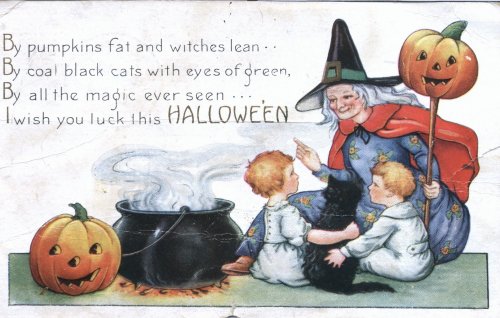 |
The peaked hat is nearly universal for witches. It was common rural English costume and for more worldly city dwellers, became a symbol of rural backwardness. The conical version is linked to alchemy and wizardry and it was sometimes forced upon “heretics” before sending them to their fiery deaths. Its properties were supposed to concentrate mental powers, and the Scottish philosopher John Duns, used the design in his dunce cap for wayward scholars. The conical hat was also considered appropriate for elves, fairy princesses, and other mythical individuals. It is associated with wisdom. No Halloween witch will be seen without one if she values her credibility. |
| The hooked nose is a sign of age. Visit any nursing home and you’ll see that our cartilaginous noses and ears continue to “develop” with age. If we could peek under the witches’ straggling hair we’d no doubt find big ears, too. The broomstick as a means of air-born transportation is one of several possible choices. Pitchforks, poles, or even chairs are also options. The wicked witch in the Wizard of Oz used a bicycle. | 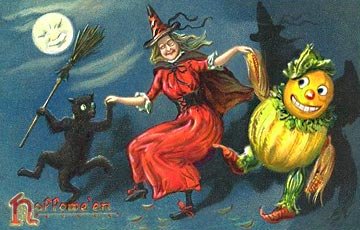 |
The movie witch also dressed in black thereby dooming post 1939 witches to that color or lack thereof. Her only color was that dreadful green face. The good witch, you recall, wore pink. The ruby slippers themselves, were taken from the witch who met her end under the house. She had worn those lovely ruby shoes with striped socks, certainly a fashion faux pas in any era. If witches were portrayed in black at the time of the early woodcuts, it may have been more a case of available ink color or printing techniques than actual color. Black is the color of mourning and has association with death that is part of Halloween and the end of the agricultural cycle at its core.
In the postcard era of 1900 to 1930, witches were common elements on Halloween postcards. While they would almost never be without a cape and pointy hat, their colors spanned the rainbow. Floral print dresses were also acceptable. Hats and cloaks could be red, green, or anything. Perhaps the bright colors were the invention of the postcard artists and marketers, but they look better to me than the traditional black robes. It’s time to break free of that limitation and bring out color in your next witch costume. The postcards shown here may give you some ideas.
In our time we can turn the myth of witches into a game of costume and
prank. But, we should not lose sight of the hundreds or thousands of innocent,
mostly poor, women and a few men who were tortured and killed in earlier
times for this ignorant superstition.
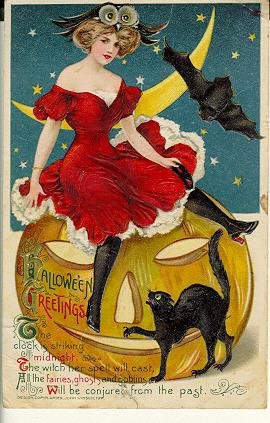 |
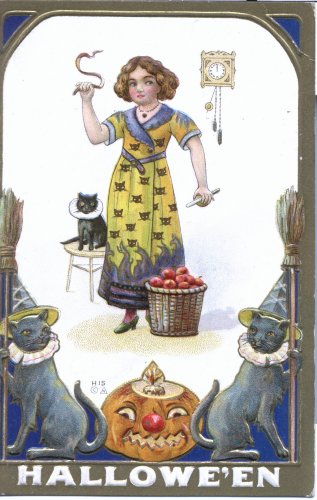 |
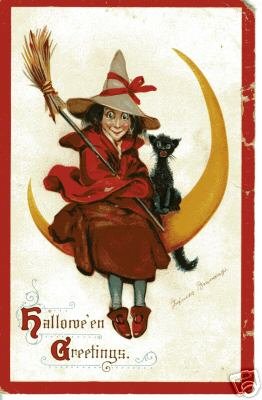 |
|
|||
|
| The History Center on Main Street, 83 N. Main Street, Mansfield PA 16933 histcent83@gmail.com |